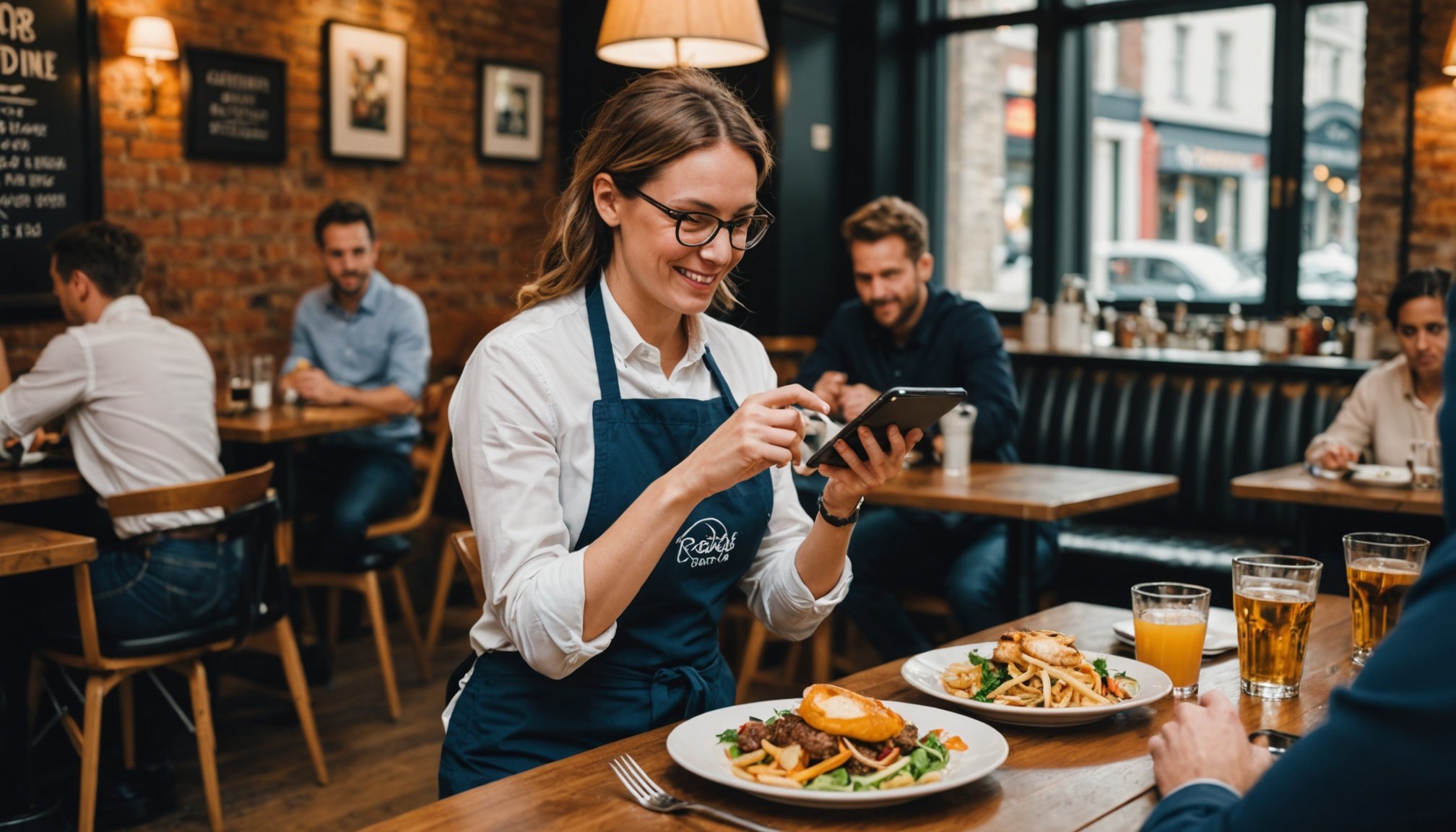Transforming Dining Profits: Key Strategies for UK Restaurants to Elevate Their Online Ordering Experience
In the ever-evolving landscape of the restaurant industry, adapting to the digital age is no longer a choice, but a necessity. For UK restaurants, optimizing their online ordering experience is crucial for attracting new customers, enhancing customer satisfaction, and ultimately, increasing profits. Here’s a comprehensive guide on how to achieve this transformation.
Choosing the Right Food Delivery Platforms
When it comes to selecting the best food delivery platforms, UK restaurants have a plethora of options. Each platform offers unique benefits and challenges, so it’s essential to evaluate them based on your business goals.
Also to read : Proven Strategies for UK Online Retailers to Curb Shopping Cart Abandonment
Key Platforms in the UK
Here are some of the most popular food delivery apps in the UK, each with its own strengths:
| Feature | Just Eat | Deliveroo | Uber Eats | UpMenu | Scoffable | Foodhub |
|---|---|---|---|---|---|---|
| Pricing Model | Commission-based | Commission-based | Commission-based | Monthly fixed price | Commission-based | Fixed monthly fee |
| Commission Fee | 14%-30% | 20-30% | 15%-25% | 0% | Lack of information | 0% |
| Additional Costs | Service charge | Service fee | Tablet rental fees | No | Lack of information | Transaction fee |
| Customer Data Ownership | No | No | No | Yes | No | Yes |
| Marketing Tools | Yes, some paid extra | Yes, some paid extra | Yes, some paid extra | Yes | Yes | Yes, some paid extra |
| Loyalty Program | Yes | Yes | Yes | Yes | Yes | Yes |
Just Eat, for instance, is the UK’s largest food delivery app, offering extensive reach and ease of use for restaurants of all sizes. It provides affordable onboarding for small eateries and features a user-friendly platform to streamline orders[1][2].
In parallel : Powerful Strategies to Bolster Data Security in UK E-Commerce: Your Comprehensive Handbook
Deliveroo, on the other hand, is known for its high-quality UI and premium branding, attracting a more affluent user base and higher average order values. However, it operates in a highly competitive environment, making optimization and promotion strategies crucial[2][5].
Uber Eats leverages Uber’s global logistics network, ensuring efficient deliveries and offering flexible payout schedules to support cash flow. It also provides competitive commission rates and additional marketing packages[1][2].
UpMenu stands out by offering a monthly fixed price with no commission fees, allowing restaurants to maintain full control over their customer data and marketing strategies. It also enables restaurants to create customizable restaurant websites with online ordering capabilities[2].
Negotiating Commission Rates
Negotiating better terms with food delivery apps can significantly impact your profitability. Here are some strategies to consider:
- Highlight Your Order Volume: Apps may offer reduced rates for restaurants with consistently high order volumes.
- Negotiate During Onboarding: Leverage introductory offers or discounted commission rates when joining a new platform.
- Build a Multi-App Strategy: Partner with multiple apps and use your leverage to negotiate favorable terms[1].
Optimizing Your Menu for Delivery
A well-designed menu is key to maximizing success on food delivery apps. Here are some tips to optimize your menu:
Prioritize Delivery-Friendly Items
Choose dishes that maintain quality during transit, such as sandwiches, pizzas, or noodle bowls. These items are less likely to suffer from the rigors of delivery.
Offer Customizable Options
Allow customers to modify items to suit their tastes, such as adding extra toppings or removing ingredients. This flexibility can significantly enhance the customer experience.
Use Clear Descriptions and Photos
Include enticing descriptions and high-quality images to encourage orders. Visual appeal can be a powerful motivator for online customers.
- Analyze your menu performance regularly through app analytics.
- Refine offerings based on customer feedback and sales data.
- Consider seasonal menu changes to keep offerings fresh and relevant.
Training Staff for Online Orders
Efficient handling of online orders is essential for maintaining customer satisfaction and avoiding errors. Here are key areas to focus on:
Order Accuracy
Train staff to double-check every order before it is handed off to the delivery driver. This ensures that orders are accurate and complete.
Effective Communication
Ensure seamless communication between kitchen staff and delivery partners. Clear communication can prevent misunderstandings and delays.
Time Management
Implement systems to prioritize online orders during busy periods. This can include dedicated staff for online orders or integrated systems with your EPOS (Electronic Point of Sale) system[1].
Leveraging Digital Marketing Strategies
In today’s digital age, a robust online presence is crucial for attracting new customers and retaining existing ones. Here are some digital marketing strategies to consider:
Social Media Marketing
Build a strong reputation through high ratings and excellent service on social media platforms. Invest heavily in brand building and guest experience to drive word-of-mouth marketing.
- Use platforms like Instagram and Facebook to showcase your menu items and behind-the-scenes moments.
- Engage with customers by responding to comments and reviews.
- Run targeted ads to attract local customers and increase brand awareness.
Email Marketing
Implement email marketing campaigns to keep customers informed about new menu items, promotions, and special offers. Personalized emails can foster customer loyalty and encourage repeat orders.
Restaurant Website and Online Booking
Having a user-friendly restaurant website with online ordering and booking capabilities is essential. It allows customers to easily place orders and make reservations, enhancing their overall experience.
- Ensure your website is mobile-friendly, as a significant portion of online orders come from mobile devices.
- Integrate your website with your EPOS system for seamless order management.
- Use customer reviews and testimonials on your website to build trust with potential customers[3][4].
Preparing Your Restaurant for Emerging Changes
To thrive in the future food delivery landscape, restaurants must proactively adapt and innovate. Here are some key strategies:
Partnering With Multiple Platforms
Diversify your presence across multiple apps to reach broader audiences. Test new or emerging apps with innovative features to expand your reach.
Adopting Advanced Technology
Invest in smart POS systems that integrate seamlessly with multiple delivery platforms. Explore tools for automated order management and performance tracking to streamline operations and reduce errors[1][4].
Emphasizing Brand Differentiation
Highlight unique menu items or services that stand out in crowded markets. Use personalized marketing to foster customer loyalty and differentiate your brand from competitors.
- Offer exclusive deals or loyalty programs to loyal customers.
- Use data from your EPOS system to personalize marketing messages and offers.
- Engage in local community events and sponsorships to build a strong local presence.
Managing Costs and Challenges
While food delivery apps offer numerous benefits, they also come with significant costs and challenges. Here’s how to mitigate these:
Commission Fees
Negotiate better commission rates, especially if you have high order volumes. Consider using multiple platforms to leverage better terms.
Food Quality During Delivery
Ensure that your menu items are designed to maintain quality during transit. Use appropriate packaging and delivery methods to preserve the integrity of your dishes.
Customer Service
Maintain high standards of customer service by ensuring timely deliveries, accurate orders, and responsive communication. Positive customer reviews can significantly boost your online presence and attract new customers[1][5].
The Importance of Customer Experience
The customer experience is at the heart of any successful restaurant business. Here’s how to enhance it in the context of online ordering:
Real-Time Updates
Use platforms that offer real-time updates on order status to keep customers informed. This transparency can build trust and satisfaction.
Personalized Interactions
Use data from your EPOS system and customer feedback to personalize interactions. Offer customized recommendations and special offers based on customer preferences[4].
Loyalty Programs
Implement loyalty programs that reward repeat customers. This can include points systems, exclusive discounts, or special menu items available only to loyalty program members.
- Make sure your loyalty program is easily accessible through your app or website.
- Communicate the benefits of your loyalty program clearly to encourage participation.
- Use social media to promote your loyalty program and engage with members.
Transforming your restaurant’s online ordering experience is a multifaceted task that requires careful planning, strategic execution, and continuous adaptation. By choosing the right platforms, optimizing your menu, training your staff, leveraging digital marketing strategies, and managing costs effectively, you can significantly increase your restaurant’s profits and attract a loyal customer base.
As Just Eat emphasizes, “The platform allows customers to easily search for local takeaway restaurants, place online orders, make payments, and select between pickup or delivery options.” By aligning your business with such platforms and implementing the strategies outlined above, you can ensure that your restaurant remains competitive and thriving in the dynamic UK food delivery market[2].
In the words of Deliveroo, “Promotions on Deliveroo allow restaurants to apply discounts to their menu, helping attract more orders and reach new customers.” By understanding the role of discounting and other marketing strategies, you can drive significant increases in revenue and profitability[5].
In conclusion, the key to success in the online ordering space is to be proactive, innovative, and customer-centric. By embracing these strategies, UK restaurants can not only survive but thrive in the ever-evolving digital landscape.











